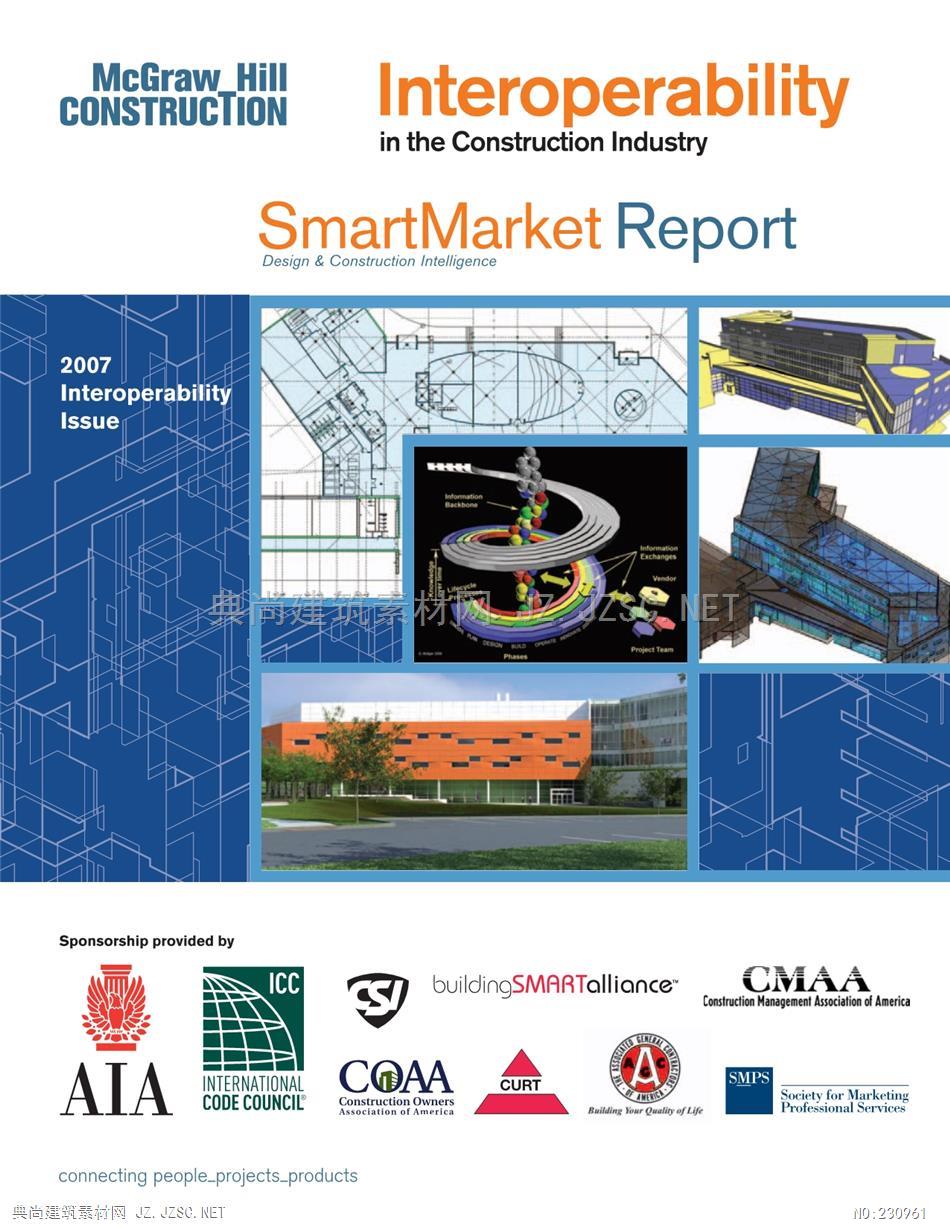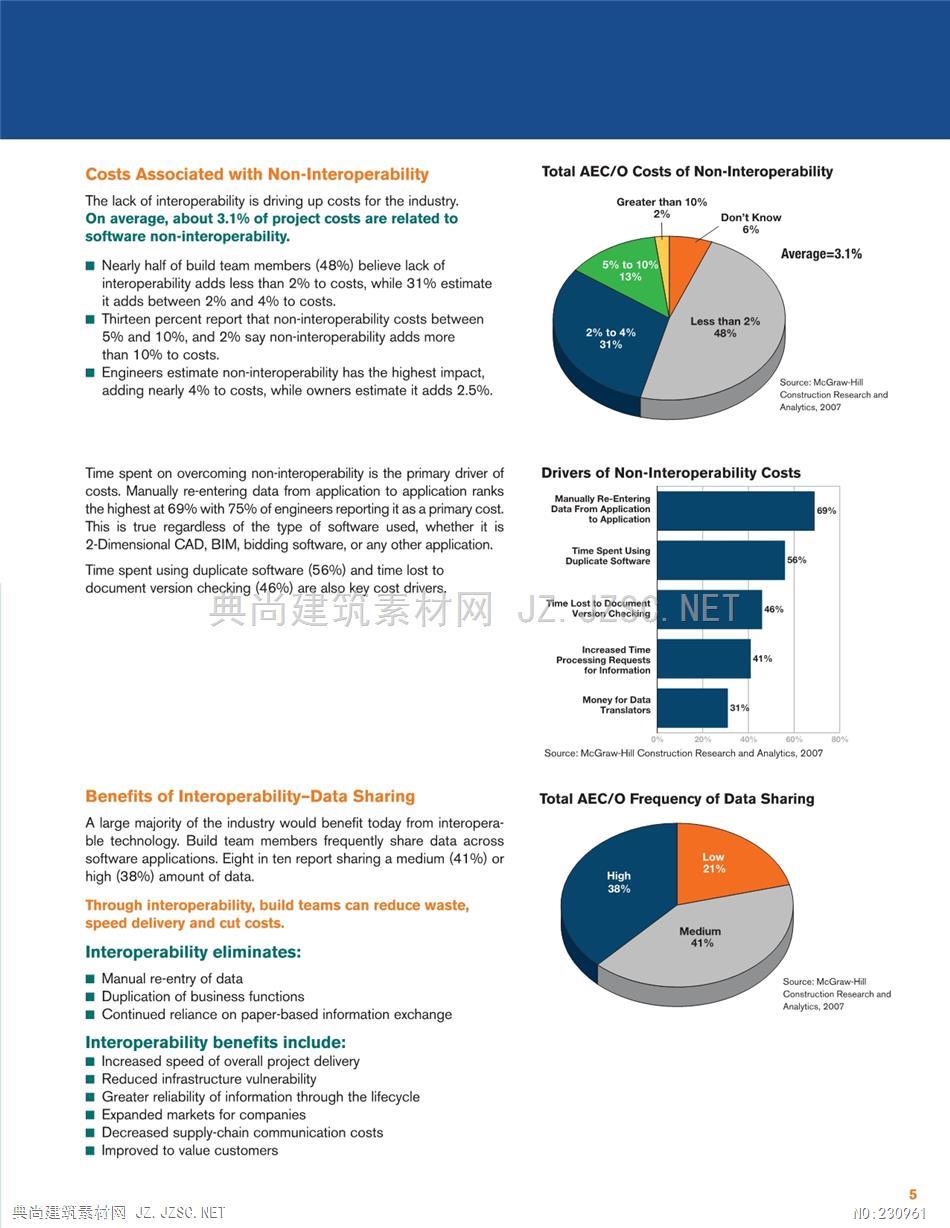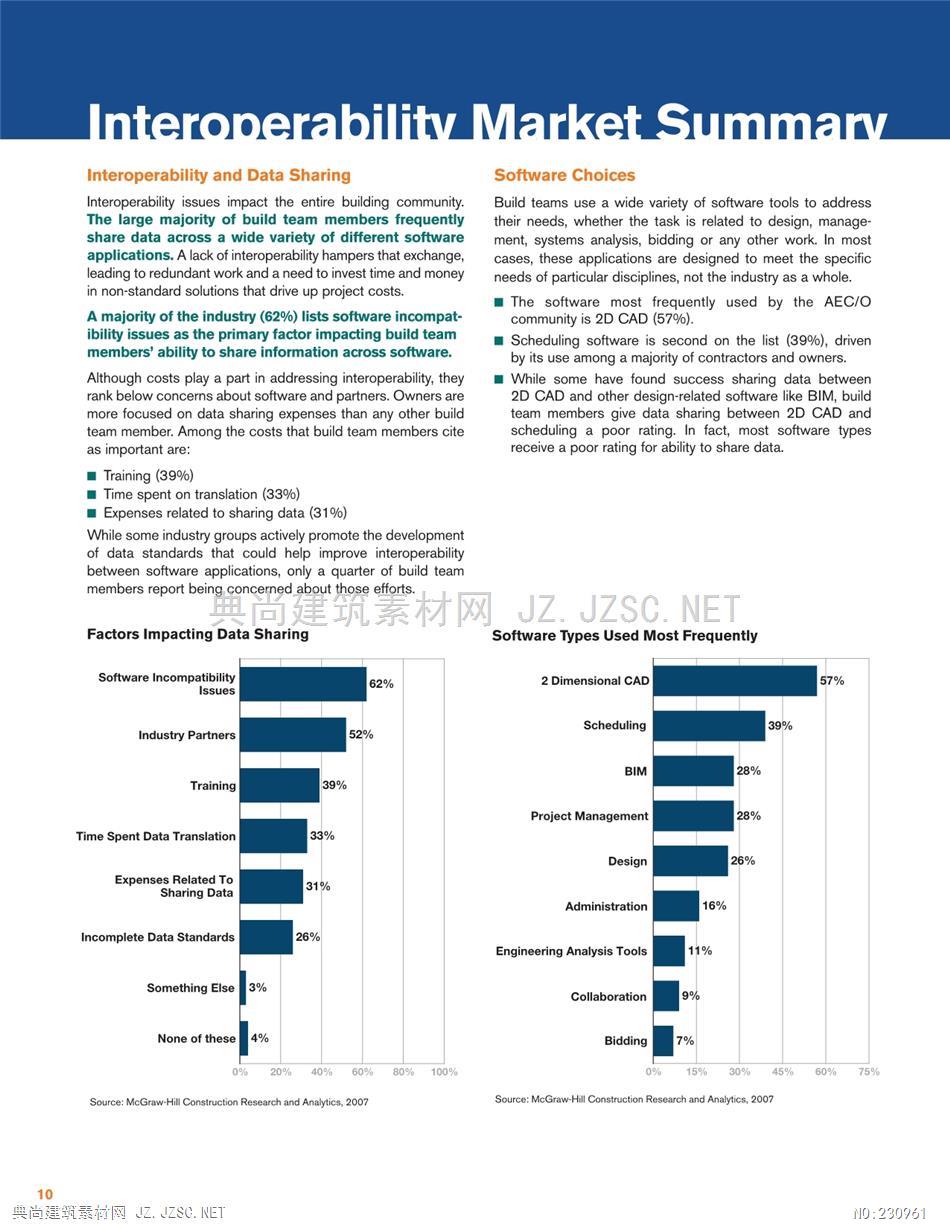









IntroductionNorbert W.Young Jr.,FAIA,President,McGraw-Hill ConstructionStephen A.Jones,Senior Director,Business Development,McGraw-Hill ConstructionHarvey M.Bernstein,F.ASCE,Vice President,Industry Analytics,Alliances andStrategic InitiativesUndeniably,the construction industry is in the midst of an unprecedented technological revolutionDue to the highly fragmented nature of our industry however,this sweeping change is manifested inthousands of custom and commercial applications being deployed in uncoordinated ways by tensof thousands of firms on over a million projects every year.To quote author William Gibson,"Thefuture is already here,it's just not evenly distributed"While individual adopters may be enjoying a variety of benefits from these "point solutions,theindustry as a whole is being held back from quantum advance because the tools,powerful as theyare in their own right,don't pass information seamlessly among themselves.This situation is madeeven less tolerable because our industry is also rapidly adopting principles and practices of inte-grated project delivery which strive to eliminate long-standing inefficiencies and avoid oft-repeatedproblems by sharing knowledge and collaborating earlier in the process with all members of thedesign,construction and operations lifestyles.As people are learning to work and communicateNorbert W.Young Jr.more effectively for the overall benefit of both their companies and their projects,their IT tools needto evolve to support this new way of doing business.This McGraw-Hill Construction research study,sponsored by the American Institute of Architects(AIA)international Code Council (ICC).Associated General Contractors of America (AGC),Construction Users Roundtable (CURT),Construction Owners Association of America (COAA),Construction Management Association of America(CMAA),Construction Specifications Institute(CSI),Society of Marketing Professional Services (SMPS),and the buildingSMART Alliance,isintended to capture a variety of perspectives on the current status and importance of interoperabil-ity in the North American construction market and potential paths towards solutions.In this way itserves both as a valuable snapshot of where we are today,and as a baseline for understanding andappreciating future progress we will make for our industry by working effectively together.Norbert Young is a registered architect,with professional affiliations in The American Institute of Architects,Stephen A.Jonesthe Urban Land Institute,the Construction Specification Institute and the International Alliance forInteroperability,where he served as Chairman of the IAl-NA Board of Directors.In addition,Norbert serves asa trustee of the National Building Museum and is the former chairman of the board of regents of the AmericanArchitectural Foundation.He is also a member of the Construction Users Roundtable,a national organizationof over 50 major owners focused on providing the"voice of the owner"to the design and construction indus-try.Norbert is a Fellow of The American Institute of Architects,and in 2005 he received the Edward C.KemperAward from the AlA for outstanding service to the profession of architecture.In 2007 he received the Henry LMichel Award for Industry Advancement of Research from the Civil Engineering Forum for Innovation.Norbertis very active in education-related initiatives by serving as vice chairman of the national ACE Mentor program-ahigh-school level program designed to identify and attract new talent to the design and construction industry.Additionally he serves on the Board of Overseers of his architecture alma mater-Penn Design.Steve Jones leads McGraw-Hill Construction's initiatives in Building Information Modeling,Interoperability andIntegrated Project Delivery as well as developing alliance relationships with major corporations for technolo-gy and content Before joining McGraw-Hill,Steve was a Vice President with Primavera Systems,the world'sleading provider of project management software.Prior to that,Steve spent 19 years in a variety of design andmanagement roles with Architecture firms.Most recently he was a Principal and Board of Directors memberwith Burt Hill,one of the largest architectural/engineering firms in the world.Steve holds an MBA fromWharton and a BA from Johns Hopkins.Harvey M.BernsteinHarvey Bernstein,Vice President,Industry Analytics,Alliances and Strategic Initiatives,F.ASCE,overseesMcGraw-Hill Constructions'Research and Analytics division.He has served as a member of former Secretaryof State Colin Powell's Advisory Committee on Leadership and Management.He currently serves as a mem-ber of the Princeton University Civil and Environmental Engineering Advisory Council,the Harvard Joint Centerfor Housing Policy Advisory Board and a visiting Professor with the University of Reading's School ofConstruction Management and Engineering in London,England,where he also serves on their InnovativeConstruction Research Center Advisory Board.He has written numerous papers and reportscovering innovation,productivity,energy conservation and green building and co-authored the book Solvingthe Innovation Puzzle:Challenges Facing the Design and Construction Industry (ASCE Press,1996).理蜀Z.ZS0.ET What is Interoperability?Definitions of InteroperabilityDefinitions of BIMInteroperability is viewed with both a narrow and broadLike interoperability,Building Information Modeling (BIM)can beperspective by the construction industry.From a purelydefined from both a technology and process point of view.Thetechnology-based view,interoperability is the ability toNational Institute of Building Sciences(NIBS)in its National BIMmanage and communicate electronic product andStandard defines BIM as"a digital representation of physicalproject data among collaborating firms.and functional characteristics of a facility.As such it serves as ashared knowledge resource for information about a facility form-However,many build team members also see interoperability ating a reliable basis for decisions during its lifecycle from incep-a cultural level.Beyond the technology,interoperability is oftention onward.This database contains the physical and function-defined as the ability to implement and manage collabora-al characteristics of a structure composed of intelligent objectstive relationships among members of cross-disciplinaryrather than lines,arcs,and text.BIM can render multiple views ofbuild teams that enables integrated project execution.data including 2D drawings,lists,text,3D images,animation,asThese perspectives are interrelated and can be symbiotic.well as elements of time/scheduling (4D)and cost(5D).Interoperability of technology enables efficiency at a practiceAs noted above,BIM is also a way to share data throughout thelevel.If all members of a build team can freely exchangeentire lifecycle of the structure.This data can include the initialdata across different applications and platforms,everydesign data;geospatial information;financial and legal data;member of the team can better integrate the projectmechanical,electrical,and plumbing (MEP)layout;buildingdelivery.Many firms are already moving toward more collabo-product specifications,environmental and energy modelingrative teams,especially with the expanded use of design-assistresults;and other information that can be used collaboratively byand design-build on projects.As teams become more integrat-architect,engineer,contractor,and owner(AEC/O)profession-ed,they are increasingly demanding technology solutions thatals during the project life cycle and by facilities managers afterbenefit those relationships.the project is completed.BIM and InteroperabilityFactors Influencing the Use of BIMMInteroperability issues are gaining attention with increased useLess Time Drafting More Time Designingof BIM.In addition to using BIM to create 3D design,theseOwners Demanding ItOn Their Projectsmodels are a rich database of the physical and functional char-acteristics of a facility.In order to optimize the use of BIM,it isBIM's Ability to Improve Communication with Clients/Others in Design and Construction Processcritical that much of this BIM data be shared between47%build team members.As a result,interoperability ofParametric Modification of Designs With BIMtechnology is an important factor.Re-entering datafrom a BIM into another application or platform usedOpportunity to Reduce Construction Costsby the build team creates wasteful and costly duplica-tion.Improved InteroperabilityThe promise of improved interoperability ranks among the fac-Reduced Number/Need for Information Requeststors that have the greatest influence on the decision to use09BIM(41%).Imoroved Document Version ControlOther key factors include:Improved Budgeting/Cost Estimating CapabilitesOwners demanding it (49%)Opportunity to Reduce Construction TimeBIM's ability to improve communication amongthe build team (47%)Clash Detection Capabilities of BIM ToolsThe opportunity to reduce construction costs(43%).33%Reducing Insurance Claims Because of BiM31%Improved Scheduling Capabilities with BIM Toois26%25%Safer Worksites Because of BIM19%Industry Use of Lean Construction Techniques Enhanced by BiM16%10209304060609%670Source:McGraw-Hill Construction Research and Analytics,2007筑素布Z.Z心. Costs Associated with Non-InteroperabilityTotal AEC/O Costs of Non-InteroperabilityThe lack of interoperability is driving up costs for the industry.Greater than 10%On average,about 3.1%of project costs are related to2%Don't Knowsoftware non-interoperability.6%Average=3.1%Nearly half of build team members (48%)believe lack of5%to10%interoperability adds less than 2%to costs,while 31%estimate13%it adds between 2%and 4%to costs.Thirteen percent report that non-interoperability costs betweenLess than 2%5%and 10%,and 2%say non-interoperability adds more2%to4%48%31%than 10%to costsEngineers estimate non-interoperability has the highest impact,Source:McGraw-Hilladding nearly 4%to costs,while owners estimate it adds 2.5%Construction Research andAnalytics,2007Time spent on overcoming non-interoperability is the primary driver ofDrivers of Non-Interoperability Costscosts.Manually re-entering data from application to application ranksManually Re-Enteringthe highest at 69%with 75%of engineers reporting it as a primary cost.Data From AThis is true regardless of the type of software used,whether it is2-Dimensional CAD,BIM,bidding software,or any other application.Time Spent UsingDuplicate SoftwareTime spent using duplicate software(56%)and time lost todocument version checking(46%)are also key cost drivers.Time Lost to DocumentVersion CheckingNEIncreased TimeProcessing Requests41%for InformationMoney for DataTranslators310网20%4000Source:MeGraw-Hill Construction Research and Analytics,2007Benefits of Interoperability-Data SharingTotal AEC/O Frequency of Data SharingA large majority of the industry would benefit today from interopera-ble technology.Build team members frequently share data acrosssoftware applications.Eight in ten report sharing a medium(41%)orhigh (38%)amount of data.High21%38%Through interoperability,build teams can reduce waste,speed delivery and cut costs.Medium41%Interoperability eliminates:Manual re-entry of dataSource:McGraw-HillDuplication of business functionsConstruction Research andContinued reliance on paper-based information exchangeAnalytics,2007Interoperability benefits include:Increased speed of overall project deliveryReduced infrastructure vulnerabilityGreater reliability of information through the lifecycleExpanded markets for companiesDecreased supply-chain communication costsImproved to value customers5理筑Z.ZS0.ET Current construction industry enviProductivityImpact of Interoperability on ProductivityProductivity levels within the construction industry have beenAssociated with concerns about productivity,owners anda source of intense debate in recent years.As constructionindustry groups are troubled by the level of waste resultingvalues have risen to record-high levels,productivityfrom a lack of interoperability.The industry generallywithin the industry has come under scrutiny.perceives lack of interoperability as an impediment toPaul Teicholz,Ph.D.,of Stanford University suggests that whileimproving productivity.overall industrial productivity has significantly increased in theThe National Institute of Standards and Technology (NIST,United States,construction industry productivity is on thewww.nist.org)set off alarms about the issue in 2004,estimat-decline.Teicholtz claims that while total non-farm productivitying that lack of interoperability costs the U.S.capital facilitiesmore than doubled between 1964 and 2004,constructionmarket-including commercial,institutional and industrial-facil-productivity dropped by nearly 20%during that time.ities $15.6 billion per year.On a global basis,that would equalmore than $60 billion.The study estimated that betweenHowever,industry observers,including authors of this report,0.86%and 1.24%of construction spending is directly relatedhave argued that the Teicholz study is misleading because itto inadequate interoperability.Owners bore nearly two-thirds ofuses labor as the sole measure of productivity.Several factorsthose costs.(Gallaher,O'Connor,Dettbarn,Jr.,and Gilday,can influence construction productivity,such as the skill base"Cost Analysis of Inadequate Interoperability in the U.S.Capitalof the workforce;size,scope and type of project;and siteFacilities Industry,"NIST 2004,pp.6-1-6-3).conditions and other environmental factors.Meanwhile,theconstruction industry is creating more complex structures inThe industry perceives that the problem is much greater thanless time and with higher quality than ever before.(Bernstein,the NIST study suggests.On average,build team members"Measuring Productivity:A Path to Improving Performance insurveyed for this report estimate that about 3%of project coststhe Design and Construction Industry").are related to software non-interoperability.Within today's$1.2 trillion U.S.construction market,which represents allconstruction sectors,such an estimate would equate to $36billion in annual waste.In the $4.6 trillion global market,thatwould extrapolate to $138 billion.Constant of Contracts/Workhours of Hourly WorkersSources:U.S.Dept.of Commerce,Bureau of Labor Statistics250.00%200.00%150.00%Construction Productivity Indexxepul"Non-Farm Productivity Index100.00%50.00%0.00%+196419681972197619801984198819921996200020046筑素衬网Z.Z心.ET ronmentGlobal Construction Output(2006)Total:$4.6 trillionRussia$90 billionCanada$156 billionWesternEasternEuropeEuropeAsiaUnited States$1.4 trillion$73 billion$1 trillion$1.2 trillionMiddle EastNorth Africa$37 billion$28 billionIndia$81 billionMalaysiaAfrica$12 billion$70 billionSouthAmericaAustralia/$101 billionSouth Africa$15 billionNew Zealand$82 billionSource:University of Reading (Roger Flanagan and Carol Jewelldata:Asia Construct.EuroConstruct and national statistics(All figures are in U.S.Dollars and use January 2007 exchange rates)曲当特麦KeyaeThere are severalkey players who generate large amounis of data that need to be shared among buildteam members during a project's lifecycle.Within the dynamic,continual exchange of information on a typical project,one team member's data will often affect the work of the entire team,requiring constant updating of facts,figuresand analyses.ArchitectsContractorsGenerate data related to the physical and functionalGenerate data related to scheduling,building productcharacteristics of a facility's design.quantities,cost estimating and project management.Plans and drawings are often updated throughout theEstablish and update schedules and costs informationproject lifecycle,reflecting changes in budget,schedulethat can affect the design of a project.and design elements.Three-quarters share high to moderate levels of data.Nine out of ten share high to moderate levels of data.See software incompatibility as the biggest obstacleSee software incompatibility as the biggest obstacleto data sharing.to data sharing.Estimate that lack of interoperability contributes 2.9%Estimate that lack of interoperability contributes 3.3%to project costs.to project costs.OwnersEngineersNeed regularly updated data about budgets and schedulesGenerate data related to the design of a facility'sas it is adjusted throughout the project lifecycle.systems and analysis of its characteristics.Require data related to operations and maintenance ofData from analysis can often lead to changes in design,a facility for use after a project is completed.affecting schedule and budgets.Seven out of ten share high to moderate levels of data.Data from building systems,such as mechanical,electricalSee software incompatibility as the biggest obstacleand plumbing,are used to detect potential spatialto data sharing.interferences between systems that could lead to costlyEstimate that lack of interoperability contributes 2.5%change orders.to project costs.Three-quarters share high to moderate levels of data.Building Product ManufacturersSee software incompatibility as the biggest obstacleGenerate data related to building products such asto data sharing.dimensions,weight,appearance,cost,warrantees andEstimate that lack of interoperability contributes 3.6%future maintenance.to project costs.Data affects costs and design7Z.Z心 Current construction industry enviProject LifecycleStandardsFirms and organizations throughout the construction industryIndustry groups and technology providers are experimentingare addressing the need for greater efficiency in the buildingwith standards that could establish universally accepted waysenvironment by rethinking traditional ideas of project delivery.of transferring data across different software.Through theseConventional delivery methods have often promotedstandards,technology companies can find common grounda divide between build team members,as work iswhere build teams can seamlessly exchange information.handed off from one member to the next throughoutthe process.IFC-Industry Foundation ClassesTraditional project delivery tends to focus the greatest amountIFCs are used for transferring data that represents the parts ofof effort during the construction documentation phase.At thisbuildings and their relationships to each other.Promoted by thepoint in the lifecycle,much of the design has already beenIAI since 1995,several technology providers support IFCs asa data transfer standard.Experiments with its use are ongoing.developed,but input from the construction team about costsand schedule can lead to significant design changes.(www.iai-na.org)Integrated project delivery promotes greater collaborationXML-Extensible Markup Languagebetween build team members earlier in the lifecycle.As teamXML is used for transferring data via the Internet.IAl charteredmembers work closely together during the designaecXML in 1999 to establish common schema definitions forphases,they have a greater ability to impact costsAEC/O commodity data.IAl describes it as an "organizedbefore the project progresses into the constructionbriefcase"that "will only include the small amounts of data youphases.While designers continue to be the focus of thewish to transport from one location to another,not your entireearly phases,contractors,fabricators and suppliers canoffice"(www.iai-na.org)provide design assistance to improve constructability andexpedite construction.Interoperability StandardsThe emergence of BIM technology is further promoting thisBuildingSMART Alliance,founded in 2006 as an expansion ofshift in the delivery cycle,as team members use modelingthe intemational Ailiance for Interoperability,is working to definetools collaboratively.BIM can speed exchange about modelstandards of data interoperability.Among its efforts,the groupchanges between team members and help identify problems,helped establish International Foundation Classes (IFCs),such as system clashes,earlier in the delivery cycle.which electronically define elements of a building design in aformat that can be shared among applications.IFCs are amongIn order to reap the full benefits of BIM's ability to pro-several standards currently being promoted by industry groups.mote integrated project delivery,build team membersAs part of its mission,buildingSMART,in partnership with thewill increasingly need to have interoperable solutions.National Institute of Building Sciences,is promoting open stan-dards and creating neutral ground to coordinate interoperabili-ty efforts throughout the industry.In fall 2007,buildingSMARTdedicated itself to the goal of eliminating $200 billion in construction cost waste by 2020.Traditional DesignbuildingSMART Design668ntroCost of Design ChangescontroCost of Design ChangesostostDesign!Design Devel I Const DocsConstructionDesign!Design Devel Const DocsConstructionTimeTime"Earlier Decision Making Improves Ability To Control Costs"-Graphs courtesy of Patrick MacLeamy.President of HOK and IAI International筑素衬网Z.Z心.ET ronmentndustryGrouS Several industry groups are working to promote interoperability,identify the demands of buildteam members and support solutions.While they are often working toward the same interoperability goals,thesegroups are sometimes following different paths to a solution.Some of these groups include:American Institute of Steel Construction AlSCConstruction Management AssociationAlhas been a leader in promoting digital design andof America CMAAinteroperability.In 1999 it launched and funded a multi-yearCMAA conducts an annual survey of owners.This year'sinitiative to promote Electronic Data Interchange (EDI)survey focused on information technology and its impact onthroughout the structural steel industry and thus improve theconstruction projects,particularly the ways technology can becompetitiveness of the material by reducing schedule timeused to improve project collaboration.www.cmaanet.orgneeded to get steel in place.www.aisc.orgInternational Code Council ICCbuildingSMART AllianceICC is developing protocols andsoftware.calledThis organization is dedicated to improving interoperability inSMARTcodes,for presenting code criteria in an interoperablethe building industry through such initiatives as promoting theformat.SMARTcodes would allow build teams to automatical-use of open standards that allow data sharing across differently check building information models for code compliance.software and platforms,and defining standard informationwww.iccsafe.orgexchanges that support specific workflow-use cases.www.buildingsmartalliance.orgConstruction Industry Institute Cll3xPT Strategy GroupCll helped launch FIATECH,a consortium of building industrypartners focused on identifying and accelerating the develop-This collaboration of the Associated General Contractors ofment,demonstration,and deployment of interoperableAmerica(AGC),the American Institute of Architects(AlA)andtechnology.It developed "Roadmap for Capital Projects"tothe Construction Users Roundtable(CURT),addresses inter-identify the necessary technologies to deliver its mission.operability issues as part of its/mission toward industrywww.fiatech.orgprocess transformation.www.agc.org/3xptstrategy/Open Geospatial Consortium OGCConstruction Specifications Institute CSIOGC is developing standards to improve the exchange ofCSI developed the MasterFormat and OmniClass classifica-spatial information across different systems and platformstion systems that help consistently structure project informa-www.opengeospatial.orgtion and now is developing the IFDLibrary an open dictionaryof construction terminology to improve interoperability.Open Standards Consortium for Real Estatewww.csinet.orgOSCREConstruction Owners Association of AmericaOis developing e-business standards that enable interop-COAAerability among systems used within the real estate industry.www.oscre.orgWe support the concept [of interoperability]and believe it hastremendous potential for our industry.(Jack Mumma,COAAPresident).www.coaa.orgMarkku Allison,AlAResource Architect American Institute of Architects AlAInteroperability is a hot topic around the AlA these days.Members are increasingly expressing their struggles withdata sharing on projects.When trying to translate data between architects and contractors for quantity takeoffs andestimating,for example,teams often run into obstacles.Even when data can be transferred,the results are mixed."[Architects]are experiencing frustration from a lack of clear and complete translation of intelligent data,"Allison says."They might try to transfer files between applications and get only partial results.Geometry data might translate,butthe intelligent data associated with the geometry might be lost.They get partial results,but because those results arepartial that raises question marks about the accuracy.It casts a cloud on the entire exercise."In some cases,such as mission-critical work,architects and their build team partners "hack away at it until they finda workaround."These can be time-and labor-intensive exercises that don't always prove successful.In the end,teamssometimes have to compromise on data they are able to share.It's a process that often repeats itself with each newproject."Every time you have a project with a new consultant [who uses]a different software,you spend a lot of time figuringout file-sharing protocols and file-saving protocols,"he adds."That takes a big chunk of time."9理蜀Z.Z0.ET Interoperability Market SummaryInteroperability and Data SharingSoftware ChoicesInteroperability issues impact the entire building community.Build teams use a wide variety of software tools to addressThe large majority of build team members frequentlytheir needs,whether the task is related to design,manage-share data across a wide variety of different softwarement,systems analysis,bidding or any other work.In mostapplications.A lack of interoperability hampers that exchange,cases,these applications are designed to meet the specificleading to redundant work and a need to invest time and moneyneeds of particular disciplines,not the industry as a whole.in non-standard solutions that drive up project costsThe software most frequently used by the AEC/OA majority of the industry(62%)lists software incompat-community is 2D CAD (57%).ibility issues as the primary factor impacting build teamScheduling software is second on the list (39%),drivenmembers'ability to share information across software.by its use among a majority of contractors and owners.Although costs play a part in addressing interoperability,theyWhile some have found success sharing data betweenrank below concerns about software and partners.Owners are2D CAD and other design-related software like BIM,buildmore focused on data sharing expenses than any other buildteam members give data sharing between 2D CAD andteam member.Among the costs that build team members citescheduling a poor rating.In fact,most software typesas important are:receive a poor rating for ability to share data.Training(39%)Time spent on translation(33%)Expenses related to sharing data(31%)While some industry groups actively promote the developmentof data standards that could help improve interoperabilitybetween software applications,only a quarter of build team筑紧members report being concerned about those efforts.Factors Impacting Data SharingSoftware Types Used Most FrequentlySoftware Incompatibility62%2 Dimensional CADIssuesScheduling39%Industry PartnersBIM28%Training39%Project Management28%Time Spent Data Translation33%Design26%Expenses Related ToSharing DataAdministration16%Incomplete Data Standards26%Engineering Analysis Tools11%Something Else3%CollaborationNone of these4%Bidding7%0920%40%60%80%100%15%30%45%60%75%Source:McGraw-Hill Construction Research and Analytics,2007Source:McGraw-Hill Construction Research and Analytics,200710Z.Z0
本站所有资源由用户上传,仅供学习和交流之用;未经授权,禁止商用,否则产生的一切后果将由您自己承担!素材版权归原作者所有,如有侵权请立即与我们联系,我们将及时删除